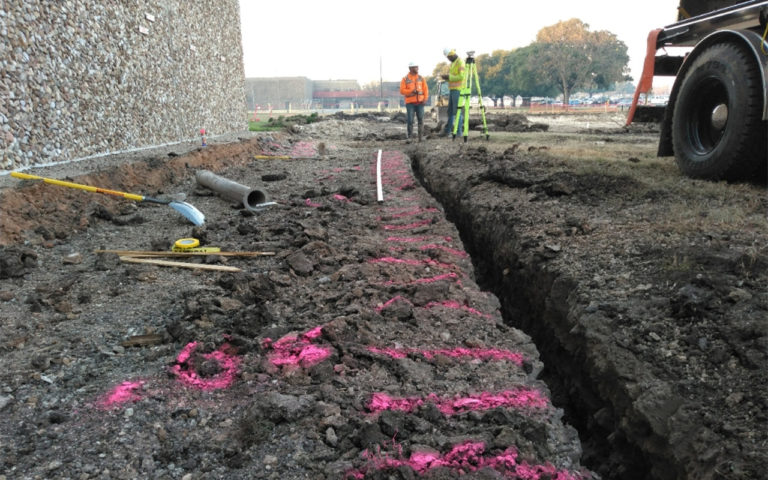What Actually is a Cross Bore?

One of my first assignments at Colliers Engineering & Design was to do research into cross bores, as it relates to Subsurface Utility Engineering (SUE), for an article. New to the world of engineering, I decided to jump into finding articles and white papers about a dangerous intersection hidden under the surface.
The Threat Beneath the Surface
According to the American Gas Association, cross bores are the unintentional intersection of a utility underground, with the newer utility being installed through an existing pipeline. Most commonly, cross bores occur between natural gas pipelines and sewer lines.
Cross bores can be a danger for all types of contractors, homeowners and the communities surrounding them. According to the Cross Bore Safety Association, the most danger lies within utilities intersecting with gas pipelines, which typically have a smaller pipeline. Cross bores with gas utilities are also the most dangerous, with multiple investigations and reports of lost life.
How Does this Happen?
So, how does this even happen? To better understand the dangers of cross bores, I spoke with Tre Hayes, Senior Subsurface Utility Engineering (SUE) manager from Collier Engineering & Design’s Denver office. From his experience, cross bores are created during installation of a new utility.
With so many thousands of miles of utilities right beneath our feet, it is dangerous to just be drilling and installing a new utility without a full and thorough investigation of the existing lines. According to Hayes, some contractors will create cross bores with concerns of cost-savings or by not following their bore, or hole.
“Sometimes, the contractors working on installing these new utility lines don’t have the time or expertise in boring or installing. Even more unfortunately, some contractors are more concerned with the price they are getting paid per foot of installation, rather than caring about the other lines or community around them,” Hayes said. “They think getting the job done fast is better than doing it right. Ultimately, that can lead to the loss of life and oftentimes, loss of business.”
Hayes has seen the devastation of cross bores firsthand, working alongside damage investigations where intersections existed with sanitary and gas lines. When the plumber was called to help unclog sewer pipes, he accidentally destroyed the lines in the utility, that should not be there to begin with. Once the gas begins leaking through the pipes and creating low pressure, any simple spark can cause an explosion. One move of the power tool resulted in damaged houses and loss of life.
Despite their high danger levels, cross bores were not fully known or documented until the 1970’s where a DOT investigation in an explosion resulting in death identified a natural gas pipeline was intersecting a sanitary line. Since then, organizations such as the American Society of Civil Engineers (ASCE) and the Cross Bores Safety Association (CBSA) have been dedicated to getting jobs done right and safely for everyone involved.
There is a Solution
The sad news is not much can be done to prevent the current cross bores that exist from causing issues, other than practicing extreme caution when dealing with clogged drains by investigating beforehand using cameras or other types of drones. However, there is a way we can identify cross bores safety and effectively. Thanks to advancements in technology and the power of SUE technicians, we can identify cross bores before it is too late.
With best practices for SUE investigations set by ASCE, field technicians can locate these types of intersections. This four-step process (ASCE 38-02) calls for intense research from gathering utility records from municipalities, survey data, and exposing the underground systems to document the utility’s exact locations and sizing.
Hayes states these investigations, as well as calling services such as your local 811 Call Before You Dig service, which every state has and is free to use, can prevent cross bores from becoming destructive. Coalitions of utility providers and representatives also are doing their best to keep SUE investigations top of mind when installing new utilities, with some states like Colorado even requiring them for any install.
Cross bores today are completely avoidable, but we will need to be extra safe when dealing with existing ones. I am certainly going to make sure to call professionals whenever I need something fixed or before any excavation and saving 811 as a contact in my phone for future use. SUE investigations reign supreme, and I will see you next time I learn something new and exciting in the world of engineering!

Comments are closed.